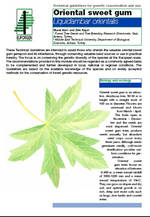Liquidambar orientalis - Technical guidelines for genetic conservation and use for oriental sweet gum
The genetic structure of populations urgently needs to be investigated for conservation purposes.
Although there are currently no comprehensive conservation measures, some practices, such as seed stands, nature conservation areas and clonal seed orchards, have contributed to the dynamic conservation process of oriental sweet gum. To meet the specific conservation requirements, these programmes must be revised to increase the population sizes and ensure representation of diverse habitats within the natural range of the species.
For species with limited genetic information, it is often assumed that genetic variation follows geographic and ecological variation. To capture the adaptive variation in oriental sweet gum, ecogeographic zones should be defined according to climatic variation. The minimum effective size of a gene conservation population is 50 trees, and it is recommended that each population is composed of at least 150-200, to ensure enough flowering and fruiting trees.
Natural regeneration should be stimulated and used wherever ecological conditions allow. Seed production is normally sufficient and seed orchards can produce seed in about seven years. To conserve and enhance the diversity in small populations it is also recommended that effective population sizes are increased by planting local material.
Local material should also be used for afforestation purposes wherever possible. For the further improvement of oriental sweet gum plantations, “selected” and “tested” material (seed or clonal) should be used in future.
In situ stands should be tended, including thinning, understory clearing, and weeding. These and other silvicultural measures in gene conservation stands are more effective than if the stands are left unmanaged.
Multiple uses of the gene conservation stands are encouraged, including oil production. Recommended oil production methods (Topçuolu, 1968) should be followed to ensure sustainable oil production. The designated gene conservation stands should serve as a source of reproductive material for breeding, afforestation, oil production and landscape planting. Utilizing well adapted seed sources is the most effective tool in genetic conservation. Trees can also be planted in forest riverbeds to act as a firebreak for Pinus brutia, and this should be promoted to increase the use of this species.
In order to conserve sufficient genetic variation to maintain the adaptive potential of oriental sweet gum, it is recommended that a network of in situ gene conservation stands is established throughout the distribution area. Several fairly small populations could be selected for the establishment of such a network. Since oriental sweet gum exists in mixed stands with Platanus orientalis and Alnus orientalis which are also Noble Hardwoods, a few natural populations could be extended to conserve the associated species. This in situ network should be complemented with ex situ collections, which will also enable provenance research. The establishment of new clonal seed orchards should be especially considered for oil production to reduce the pressure on natural stands.
In regions where seed sources are limited, local ex situ collections (stands) should be established to serve both conservation and seed production. These collections should typically be established within the local region of provenance. Measures should be taken to protect them against undesired pollination from outside. These stands can be bulk collections, seedling seed orchards and clonal seed orchards. From a conservation perspective, priority should be given to resources that are threatened by extinction or contamination from undesired provenances, small populations and unique populations or individuals.
Authors: Murat Alan; Zeki Kaya
Journal/Series: EUFORGEN Technical Guidelines for Genetic Conservation and Use
Publication Year: 2003
Publication Format: Folder; PDF
ISBN: 92-9043-605-0
ISBN 13: 978-92-9043-605-8
Language: EN
Pages: 6 p.

